*Foreword: This Jeep was a corporate lease provided by the company. I recently left the company for a new job. So I had to return the vehicle to stock, and return the Jeep. It’s unfortunate, but I enjoyed my 6 months with the toaster Jeep*
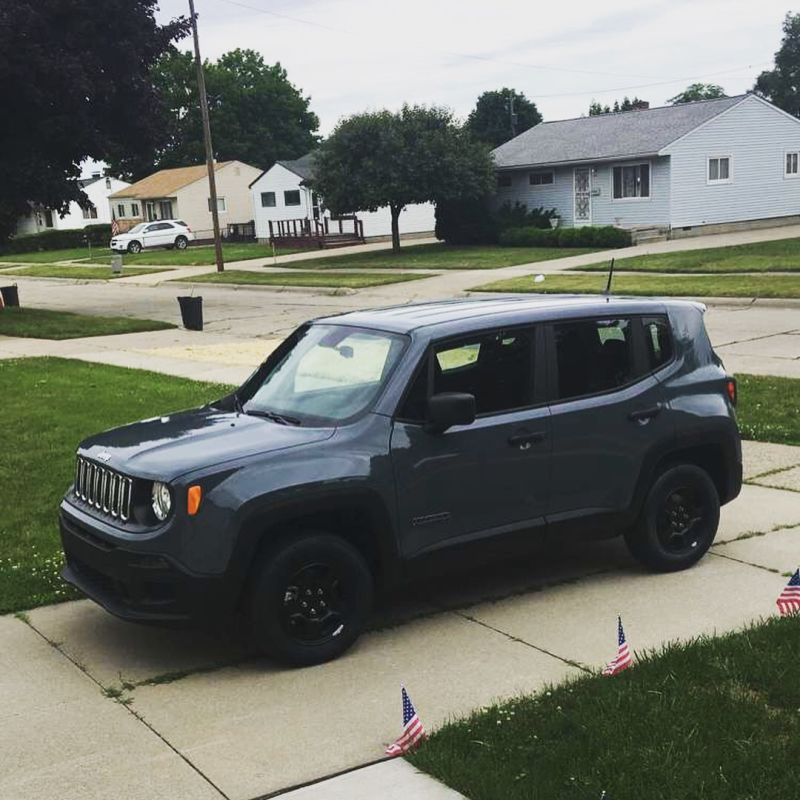
Let me start by addressing a few things:
- Apparently, if it doesn’t have live axles, body on frame, and rhyme with “shmangler”, it’s not a “real” Jeep. As you read along, one can see even the base Renegade is fairly capable out there.
-Jeep is owned by a company called Fiat Chrysler Automotive. The Renegade is built in Italy, and shares a platform with the Fiat 500x. So yes, you calling it a “Fiat” isn’t technically wrong, but that stopped being funny in 2014.
There are different opinions on one putting fake badges on their cars. I think they are acceptable-as long as they seem parodic. For example, a BMW 335i with M badges is distasteful. Put AMG badges on a Mercedes Sprinter, though, that is awesome! I mention this, because all of my vehicles have Hellcat badges on the door/fender area. This Renegade has them, and so does my 2015 Chrysler 200 (Heck, I even put a Hellcat sticker on the front fender of my Honda Ruckus!). It brings many double takes, and many more laughs.
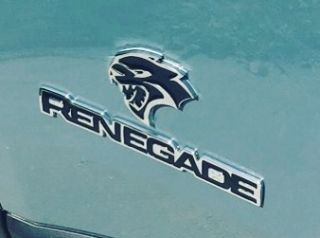
Anyone with access to the internet, or your local Jeep dealer, can look up the basic dimensions of the Renegade; so I won’t waste too much space on those numbers. What I’ll do is split it up into basic categories, and give you a mix of opinions, and observations: Modifications, Exterior, Interior, Powertrain, Towing, and Drive/Experience.
Modifications
I ordered my Anvil Jeep Renegade ticking off two options: All-weather floor mats, and A/C package. I wanted the steel wheels. I wanted the basic infotainment. More importantly, I wanted to build my own “Trailhawk”. The Trailhawk trim could not be optioned with a stick, and that’s a darn shame. So I figured with the money I saved, I can add my own mini off-roader.
*Note: No free ads, I will keep the name brands of parts out of the review. If interested in knowing the parts, shoot me a message*
The first thing I do with all my vehicles, is to pick up an aftermarket drop-in filter. I can hear some of you rolling your eyes already, but I don’t do it for performance. I do it because I am lazy, it’s reasonably priced at $45, and I don’t have to worry about it for a year. Installation was as easy as expected: few screws and a couple latches. As you all can predict, there was no noticeable difference in performance.
My next mod was something I always wanted to do to a turbocharged vehicle: I purchased a blow of plate. These always have mixed reviews by peers. I have heard critics call them “bro-off” valves in haste. To each their own. I like hearing my vehicle, so a $60 piece of metal was installed to give it the whoosh sound whenever I shift or let off the gas. Installation was fairly simple: three Allen bolts removes the diverter valve, then the plate goes between the turbo, and the diverter. Longer bolts were provided to compensate the new length. I can almost guarantee there is no performance advantage to adding a plate.
This next mod only happened thanks to the blogs and forums for the Jeep Renegade. I had my eye on a turbo blanket, but was turned off by the high cost of one. Luckily, a vendor contacted me and sold me a gently used one for almost half the cost. The average Renegade turbo wrap cost about $160-$180 depending on color and material. I lucked out and bought a used one for $95. Installation was easy: it is cut to fit right over the turbine. They claim blankets help spool turbos faster. If there was any improvement to me, it was very slight. But in regards to temperature, I noticed a significant difference in the engine bay with and without the blanket.

I did some research on forums and blogs about throttle response. I discovered the stock throttle body necked down in the bore. Also, the butterfly plate was assembled with larger than needed hardware. I found a vendor that sells ported throttle bodies. I lucked out, again, and found a guy selling one off his old Renegade for cheap. Brand new ones go for $270, I bought mine off a gentleman for $150. Installation was a little tedious. All hoses on the renegade have these hose clamps that are a nightmare to take off. I resorted to using a screwdriver and a side cutter to mangle the latch loose. After installation, I immediately felt a low-end increase. There is still your dose of turbo lag, but getting out of it takes less effort. Also, no check engine lights are triggered with this replacement.

The same fellow that sold me his throttle body, also offered his turbo actuator for $100. Online, they retail for about $190. The actuator holds the boost longer before being released, thus providing more boost to the engine. Installation was fairly simple. Here, though, you have the opportunity to adjust the rod to open the actuator more or less. I started with 3mm (3 full turns) and test drove. If you go too far, the ECU will prematurely open the actuator. 3mm was too far, I turned it back 1.5 turns and have had no issues since. You can definitely feel an improvement in the overall spool and boost, and with the other things I’ve done to it, can definitely feel an improvement in the performance of that little engine.
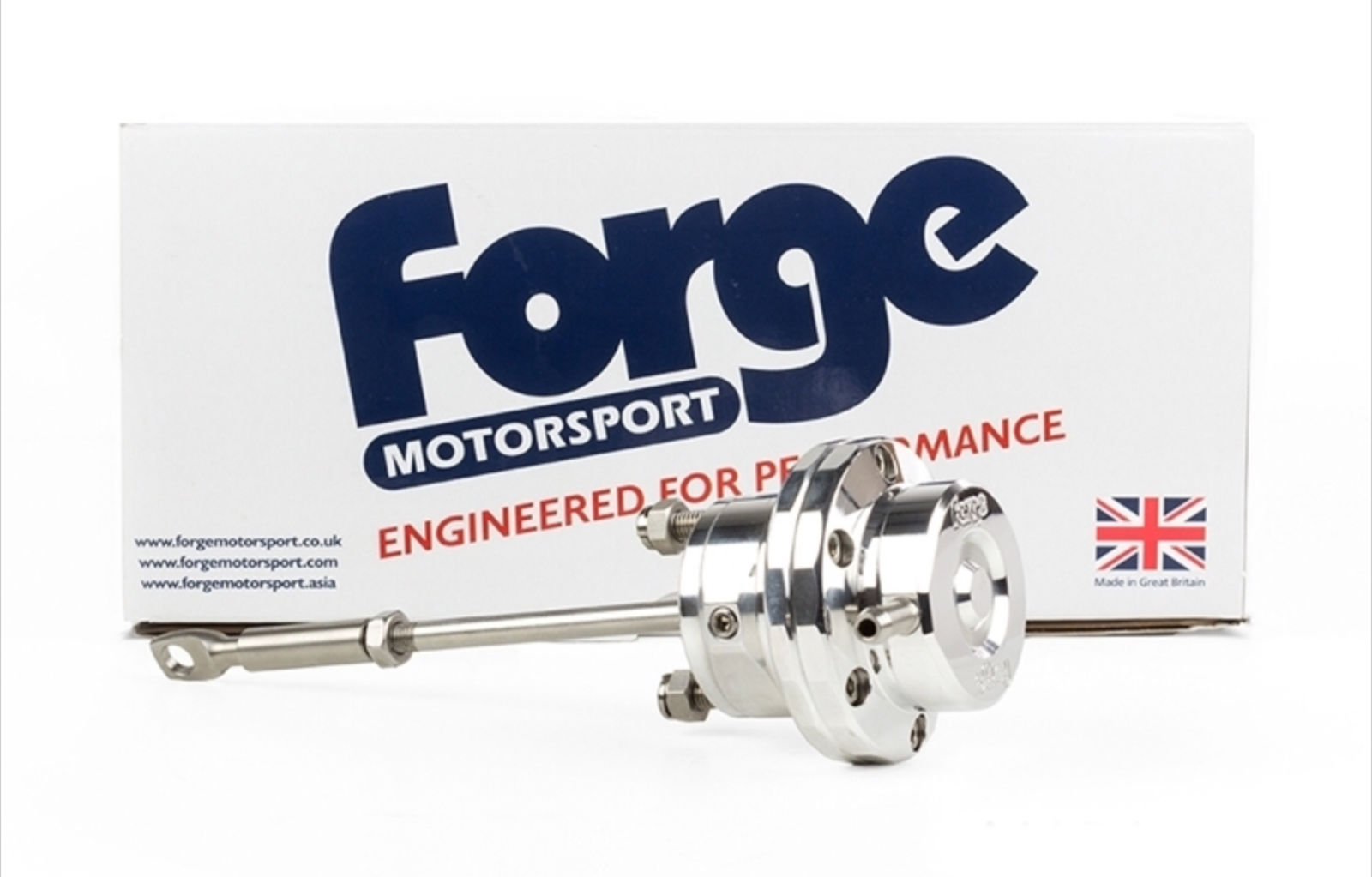
This last modification is what a lot of people are dying to know: the sound. As mentioned above, I like hearing my vehicle. So I knew I had to do something to the exhaust. The muffler is fairly easy to remove: it is clamped to the resonator pipe, and hung by two hangers towards the back. I took the vehicle for a test, and noticed a slightly louder sound. From the exterior, you can hear a little louder sound that’s appealing, and probably safe if you live next to ornery neighbors. Inside, you can only hear a difference at wide open throttle in higher RPM’s. So unless you plan on running it at high rev’s most of the day, you won’t hear a difference. There wasn’t too much a drone, which is a good thing for people worrying about that.
For me, it wasn’t enough. The resonator comes off as easy as the muffler with a clamp. You immediately hear a difference when the motor is able to breathe freely. You hear a faint whistle of the turbo, you hear a nice idle rumble, and it’s not too loud at start up. From hearing audio of the Fiat Abarth 500, I would say the idle sounds fairly similar. Low-end acceleration gives you a good grunt. The high RPM are where you’ll hear a difference. It’s throaty, loud, and doesn’t sound too “Honda Civic” sounding albeit the small engine. I haven’t heard any backfires or pops yet. I decided not to get a system welded up to save money on other stuff. A simple $8 turn down pipe from the local auto shop was installed to make sure heat, deposit, and possible flames (unlikely, just playing it safe). In comparison to the Abarth, I’d say the Abarth sound is more controlled or cleaner sounding. Obviously the sound is intended, so the exhaust on the Abarth is designed to make sound. The Renegade with the muffler and resonator removed is more brash.
My next projected upgrades will be more oriented towards the suspension and tires. I would like to put a lift kit to help with the clearance. I don’t plan on putting giant 35 tires on the Renegade, so a simple 1.5-2” lift will suffice. To go with the lift, a set of upgraded springs to complement it. I either will splurge and pick up a set of aftermarket ones, or I could find a set of Trailhawk springs for cheap off an individual. The stock tires on the Renegade are optimal for everyday commuting, but not the best for anything that isn’t dry pavement. A set of all-terrain tires will help out there. I would like to keep the stock steel wheels because I like the look of them.
Finally, a way to tow the front of the vehicle would be very helpful if I ever get myself in a sticky situation. Currently, the best way to pull the Renegade out is to hook up to the aftermarket tow hitch I had installed. I have read horror stories about people trying to pull Renegade with a tiny tow hook that’s threaded into the aluminum front bumper. Spoiler alert-most did not end well. There is a company that sells heavy duty tow hooks that are attached to brackets which then bolt onto the sub-frame. These are a little pricey at $400. Another concern is these hooks are very new to the market, and nobody (not even the vendor) has tested their strength. This may be my last thing I do to the Renegade, if I even do it. Hopefully by then, more reviews will come through to validate their strength.
Exterior
The Jeep Renegade looks like a toaster. It shares the shape of other toaster looking vehicles like the Nissan Cube, Kia Soul, Scion xB, and Honda Element. Immediately, you see the Jeep cues in a Renegade. The front end looks rugged, but at the same time give an innocent, almost soft look. You still get your standard 7 bar grille and round headlights. The wheel wells extruding out from the body give it a brawny look. The plastic trim actually looks good against once of the coolest color names I’ve heard on a regular car: Anvil.
I’m not going to go into detail of all the easter eggs that the Renegade has; there’s plenty of articles locating and listing them. I do have to admit, it’s always a good time seeing the little sasquatch, through my rear view mirror, walking along my rear window well.
I wish you could option the Trailhawk front bumper that gives you more clearance up front. It also gives you two standard tow hooks mounted onto the sub frame. I have researched doing a bumper swap, and it requires more than just swapping plastics: you’ll need nearly $700 worth of bracing and other pieces to properly swap the bumpers and have the tow hooks safely installed. It’s a thousand-dollar project, and there’s several aftermarket vendors that offer a bumper for less.
Sometimes, I forget how small the Renegade is. The other day, I parked next to a current generation Ford F-150 regular cab. I could not see the Jeep when standing on the other side of the truck. The height is short, the length is short, and the width is narrow. This poses an advantage when maneuvering through city streets and parking lots. I find myself more confident in parallel parking the Renegade than any other car I’ve driven. The tight turning radius and flat front end play a huge role in that; the end of the hood is pretty much the front of the vehicle. Being narrow is beneficial when navigating through crowded parking lots full of people who don’t know how to park.
The Renegade truly stands out compared to its competition. Vehicles like the Chevy Trax, Honda HR-V, Ford Ecosport, Nissan Rogue, and Kia Soul all seem to blend the same basic form and shape. Some of them try and give a car-like shape, others look like miniature versions of their bigger brothers in their respective brands. The Jeep give you authentic looks from the front to the back. At the same time, it also looks inoffensive (looking at you, Juke). It’s hard to find a better looking compact utility vehicle out there now than the Jeep Renegade.
Interior
The Jeep Renegade continues its tradition of implementing as many Jeep cues as possible in the interior. There are your basic metallic looking trim to contract the mostly black plastic, cloth, and faux-leather. Everything is easy on the eyes, which is relieving because the Trailhawk’s interior trim is laced with red. I love the redline marker being a splatter of mud. Just one of the several interesting easter eggs inside the cabin. There’s plenty of open storage areas, but the enclosed center storage bin is a bit undersized. Following that, the arm rest sits directly over the second cup holder in the center. I’ve almost knocked my drink a few times clipping that arm rest. Also, I wish the windshield wiper had more intermittent settings. There’s a low, medium, constant slow, and constant fast. I wish there was one more setting in between low and medium.
Since this has no extra options, there’s no power seats. The driver seat manually adjusts fore and aft, up and down, and reclines. Although there’s no power seat, I always wish for a lumbar support lever. My 2005 Chrysler 300 had one. The passenger seat manually adjusts fore and aft, and reclines. It does not adjust seat height, which I see as a little annoying whenever I’ve rode as a passenger. I’ve taken the Renegade from Detroit to Chicago and back. I find the seat rather comfortable without aching any part of my body.
The seating position is comfortable. You feel higher up than you really are. I am 6’2” but have a longer torso. I love the amount of room I have above my head. Most vehicles I’ve driven have a seating position for longer legs than torso; and I find myself closer to the ceiling than I’d like. Finding a comfortable driving position is easy, thanks to the telescoping and tilting steering wheel. The pedal positon is ok; the foot rest is a little too close to the clutch for comfort leaving a narrow space between the rest and the brake pedal. Maybe it’s my wide feet, but I sometimes catch the brake pedal when pushing the clutch.
The rear seats sit a little higher than the fronts. This sacrifices some head room for us taller folks. There is still a surprising amount of room for passengers in the back. With the front seats set to accommodate my size, I am able to comfortable climb into the rear and sit. My knees do touch, and I doubt that would be comfortable on a road trip, but it will suffice for commuting with several passengers. Rear seats do fold the traditional 60/40 way most vehicles do.
With the rear seats up, there’s enough trunk space to hold your basic belongings. I can throw a toolbox, groceries, and a couple lawn chairs back there with ease. There’s a floorboard in the trunk that would normally cover the spare tire. Since the stock Renegade doesn’t have a spare, I ditch the floorboard completely. This gives me a few more inches of depth. With a compact vehicle like this, I’ll take every inch I can get. With the seats down, there is a decent amount of storage for your everyday needs. I mow lawns as a side gig, and I can fit the push mower (with the handle folded), weed Wacker, and leaf blower back there with room to spare.
Powertrain
Let’s talk about that engine. The turbocharged 4 cylinder loves to be revved. Ironically, that’s the best only way to keep with traffic. Your foot is at least at 50% wide open throttle at all times. This doesn’t surprise me due to the fact only 160 horsepower is hauling over 3,400 pounds. It reminds me of my 50cc scooter where you pretty much need to be on the throttle at all times. This, of course, sacrifices fuel economy. If I baby it through the city, I can get around 24 MPG. But since I love to drive the heck out of this thing, I get around 18-19 MPG.
When stock, the Renegade putters around town with minimal noise to let you know you’re accelerating. You can hear a faint turbo whistle through the firewall. If you have music at a moderate level, or even holding a conversation with a passenger, you can’t hear the car approaching its redline. It was definitely accommodated for the everyday driver with a safe amount of power and minimal engine noise.
The gearbox is forgiving and easy. I find myself easily rowing through gears with minimal force. The clutch pedal is slightly firm. I prefer a firmer pedal because I rest my foot on the pedal when not disengaging. A softer clutch pedal runs the risk of accidentally disengaging the clutch.
Towing
I needed a way to transport my 50cc scooter. The scooter could have fit in the back if I removed the front wheel and bars, but taking apart the scooter every time I move it wasn’t something that sounded fun. I needed to acquire a hitch, and a carrier.
The manual renegade is not factory rated to tow. You actually cannot spec the tow package with the manual powertrain. Luckily, there are aftermarket options out there. Continuing my tradition of going the less expensive route, I settled on a basic class III hitch from the local rental/moving company. There were cleaner looking options; you can get a $500 hitch and bumper combo to give you a cleaner look, and a higher connecting point. I saved hundreds of dollars by getting the basic hitch. I also saved on getting trailer wiring installed. I will be hauling the bike most of the time, and it does not block my rear lights or windows.
The hitch is low to the ground. The already mediocre ground clearance gets reduced even more in the rear with the hitch installed. A little online research showed European tow ratings for the manual Renegade to be about 1800 pounds, with a tongue weight of 500 pounds. *Note: these numbers were found on a forum, and may not be accurate*. The bike weighs about 200 pounds, and the carrier I picked up off craigslist was about 100 pounds. With the carrier mounted, and the bike strapped in, the Renegade squats low. The bulky steel carrier played a big role in the reduced clearance, giving me 3-4 inches in its lowest area. Any slight elevation change led to the carrier hitting the ground. I purchased a raised adapter to help me out.
With all of that put together, I took the Renegade on a road trip to Wisconsin. With the rear of the Renegade at a deep squat, and a scooter strapped to the back, I’m sure I got plenty of looks driving from Detroit to Wisconsin. The highway miles gave me no problems. The smooth elevation changes prevented me from hitting the carrier. I was impressed with how little the fuel economy was affected. On a regular road trip, I will average about 28-30 MPG. With the carrier on, I averaged about 27 MPG. Fortunately, I have found a lighter basket-style carrier to haul the bike. This one weighs about half of what the bulky carrier did. This significantly helped with ground clearance in the rear.
Driving/Experience
I find myself flooring the pedal whenever I can get away with it. That doesn’t necessarily mean I am going 80 in a 40 street. It takes me a hot second to get to 45. But those few seconds it takes to get to 45 are exhilarating. The exhaust roars with excitement as I approach the redline. I hear a small crackle as I let off the throttle to shift. I love seeing the reactions by other people as they look up expecting some modified tuner car, but instead they see a toaster making all the noise.
There’s a debate on many Renegade forums on whether or not one should put premium into the Renegade. Although it is a forced induction vehicle, and most forced induction vehicles require 93, this one does not require it. Manual says 93 is recommended for optimal performance. I have driven on both octanes, and can vouch that 93 octane will give you a little more juice. I noticed a small improvement in fuel economy as well. So if you want to maximize every bit of power from the Renny, go for the 93; if not, 87 will suffice.
The suspension feels firm on the road. Compared to bigger vehicles, you definitely react to bumps in the road. I feel confident taking on/off ramps at a higher speed than one would expect. The ride would obviously benefit with better tires; whether they be wider or have more grip overall. At the same time, I liked how the suspension acted when taking it off road (more on that soon). The brakes will stop you at a safe and adequate time. There is nothing fancy about them. They do sell aftermarket brake kits if that’s what you’re interested. But I am content with the brakes now.
I took the near stock Renegade to the local ORV park. At the time, I had the blow off plate, drop-in filter, and hitch installed. I packed tools, tow straps, shovel, and a spare set of clothes. Upon entering the park, the initial paths are simple gravel roads with a few shallow puddles. As I traversed deeper into the park, the rocks became bigger, the mounds became steeper, and the puddles got deeper. I never saw the fascination in slow rock crawling, but I commend the ones who do. I like to hit mounds, splash puddles, and sling some mud.
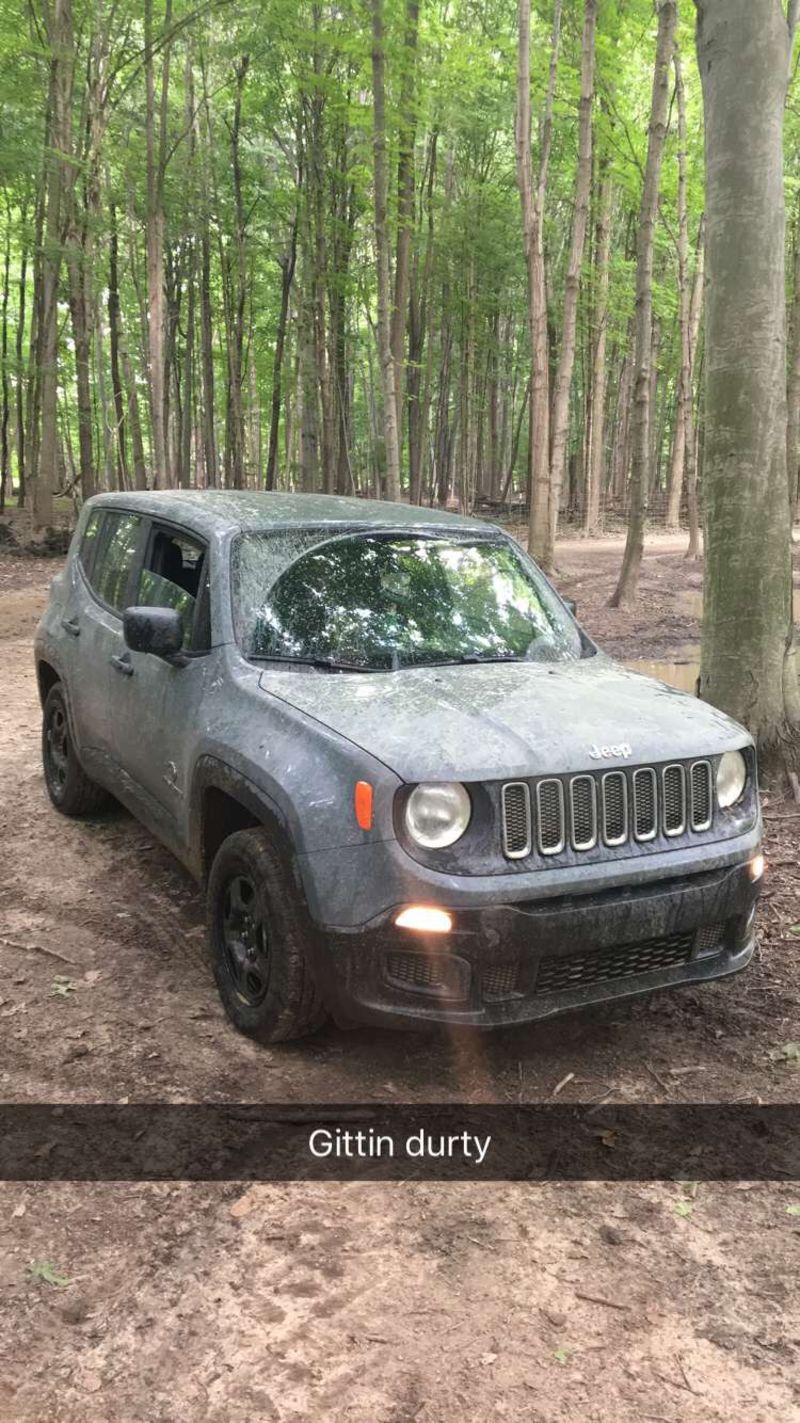
I first was reluctant around the park. As I passed other riders in their lifted trucks and dirt bikes, I got mixed reactions. Some people waved and gave thumbs up, others gave me confused or dirty looks; wondering what the mall crawler is doing here. I passed a lifted Chevy truck that was stuck in mud at least 6 feet deep. He held a tow strap and was signaling for help. We both laughed knowing the little toaster could not help him out.
After about an hour of driving through trails and pits, I started getting a little confident. I came into an open area filled with motorcycle jumps and banks, and mud holes everywhere. I quickly picked up on the pathway were dirt bikes and quads were going, and tried to avoid their path. I noticed some of the fancy quads and side-by-sides are about the same size as the Renegade, which is comical. But this also means fitting into smaller spaces on trails and banks.
I was impressed with the Renegade on the trails. It obviously suffers with its low ground clearance, tall front and rear bumpers, skinny street tires, and severe lack of power. But even with all of these factors, I only got stuck once. The suspension, as I mentioned earlier, has a good amount of give while feeling firm at the same time. I avoided rock beds for the obvious reasons. Even some grooved paths seemed too deep for the Renegade.
When I got stuck, I was more concerned about the health of the Renegade than being embarrassed. I was on a hot streak of hitting mounds and mud holes pretty consistently with minimal resistance. I came into a mud hole that was way too deep for almost anything. The second I splashed in I knew it was going to be a problem. The water was right at the bottom of the door! I got out to figure out a plan to get out of there. Passersby offered their criticism or help, depending on their mood. I knew I couldn’t pull it from the front due to lack of tow hooks. I had a guy in a Blazer help out. I hooked the tow strap to the trailer hitch (hero of the day), and he hooked his to his front. I threw the Renegade into reverse while he pulled me out. The orientation of the Jeep in that hole had me on two wheels at one point. Fortunately, we got the Renegade out. I immediately took it to the side to check for damage. With the exception of pounds of mud and sand in every crevice and corner, there was no serious damage. The engine bay had some water and mud splashed over it, but I lucked out with no water into the intake. I checked the filter for mud or water, and came out clean!
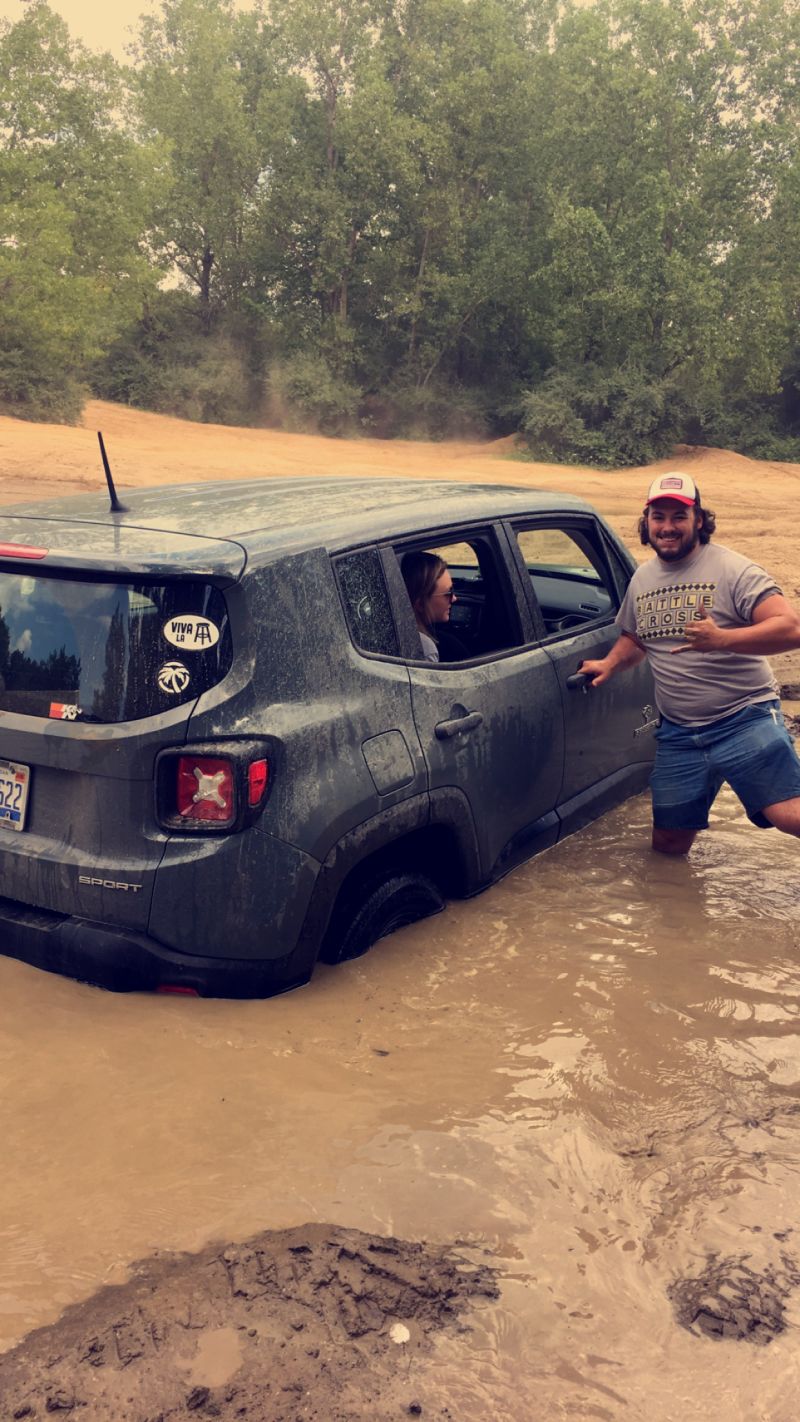
Conclusion
I am impressed with this Renegade every time I drive it. I love the simplicity of it. Yes, it has power locks and windows; but no sunroof, no navigation system, no remote start. There aren’t many bare vehicles on the market, there are even less that cost under $20,000. I wish it had a tad more power under the hood. 165 horsepower is just not enough for a toaster shaped vehicle. I am looking forward to putting better tires and a small lift on the Jeep and see how much better it performs. The Jeep Renegade manual is a car that enthusiasts should drive at least once. Some people like the quirky Jeep looks, some don’t. It can haul a minibike, hit modest trails, and put a smile on your face with that exhaust sound.